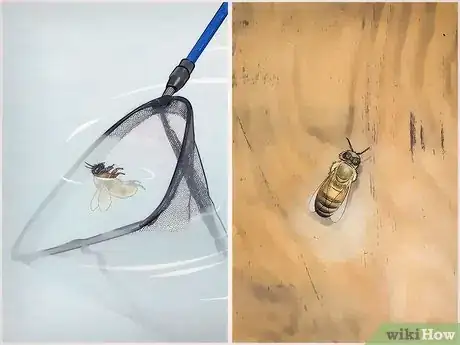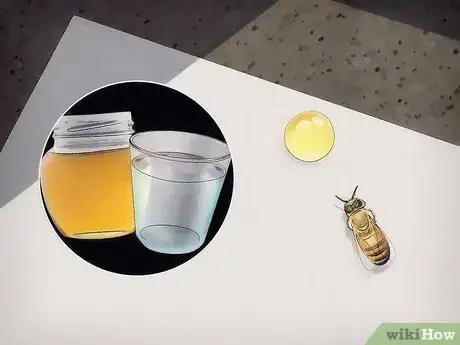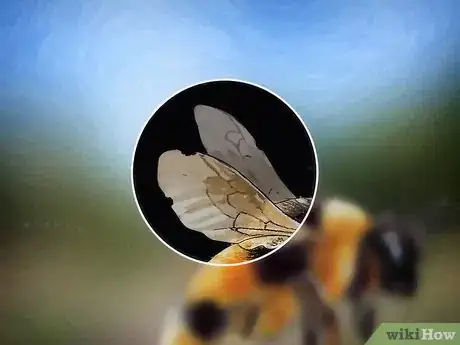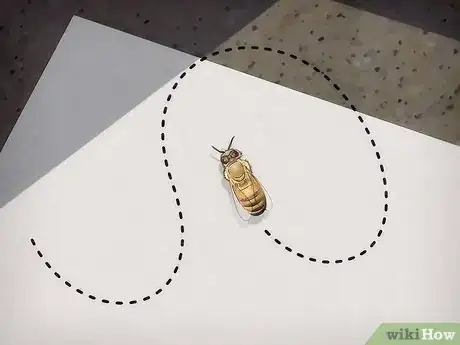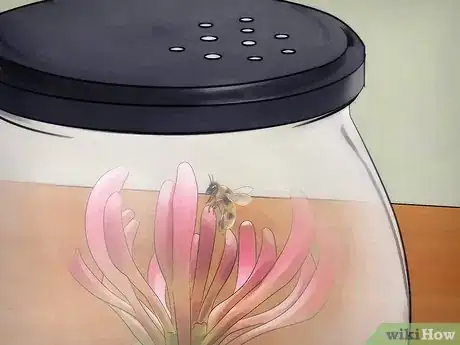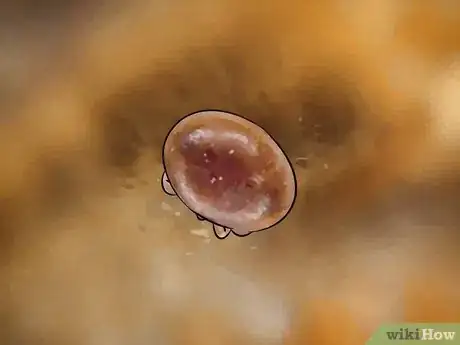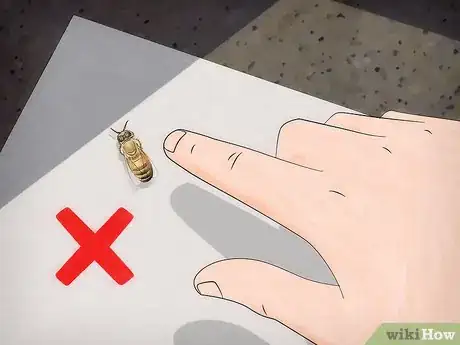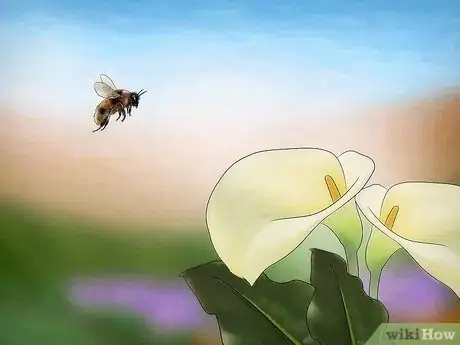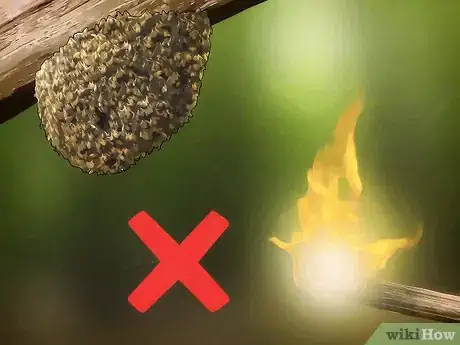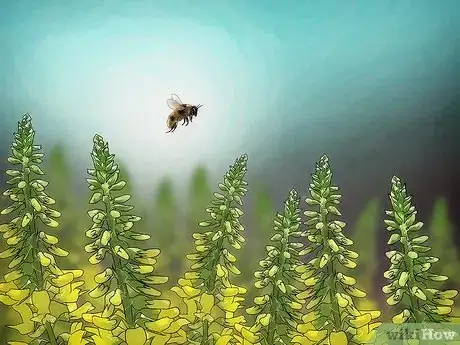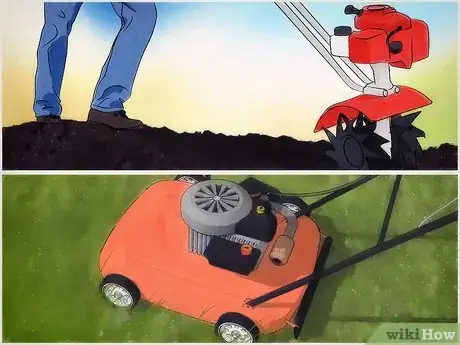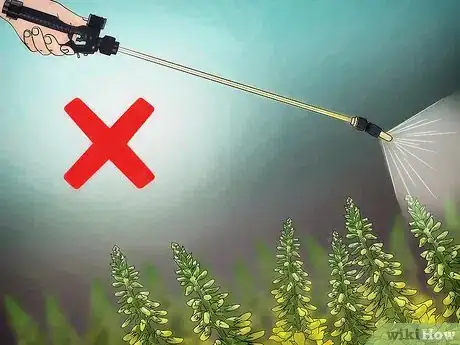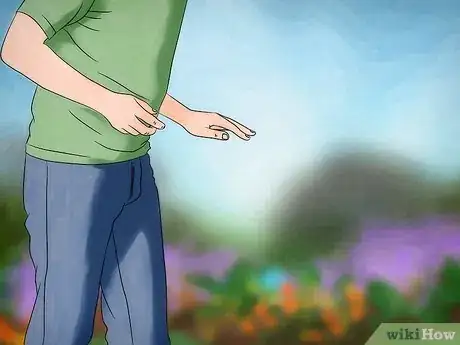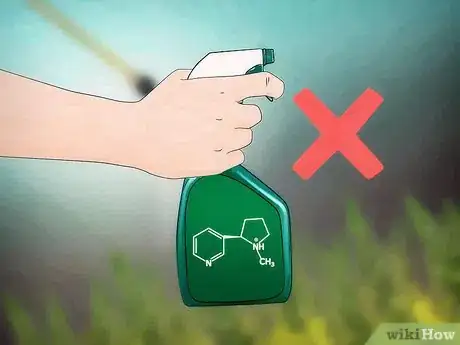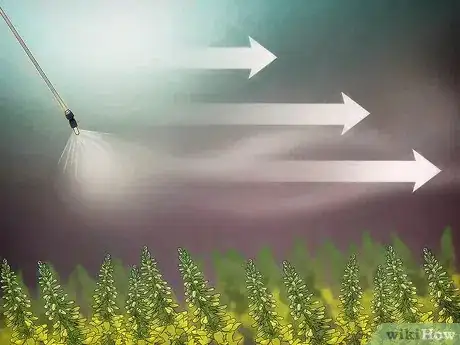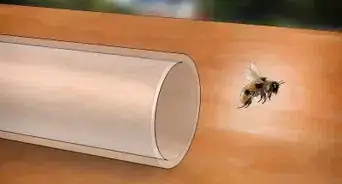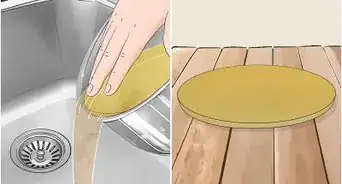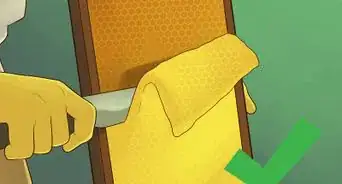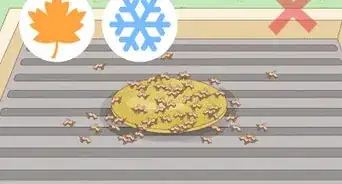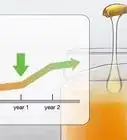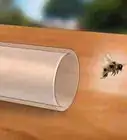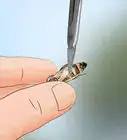This article was co-authored by Pippa Elliott, MRCVS. Dr. Elliott, BVMS, MRCVS is a veterinarian with over 30 years of experience in veterinary surgery and companion animal practice. She graduated from the University of Glasgow in 1987 with a degree in veterinary medicine and surgery. She has worked at the same animal clinic in her hometown for over 20 years.
wikiHow marks an article as reader-approved once it receives enough positive feedback. This article received 14 testimonials and 93% of readers who voted found it helpful, earning it our reader-approved status.
This article has been viewed 218,182 times.
So, you’ve found a honeybee. It’s dithering about, acting sluggish, or looking a little beat up. “I really ought to help that honeybee out,” you’re thinking. Fortunately, there are several steps you can take to help a honeybee that seems injured. There are also important steps you can take ensure that honeybees in your area are able to thrive.[1]
Steps
Treating a Bumblebee That Can’t Fly
-
1Warm up a bee that may just be cold. If it’s around 12.8 °C (55.0 °F) or colder, honeybees cannot take off. If a honeybee looks normal but is moving slowly or simply can’t seem to get off the ground, they may just be cold. Use a piece of stiff paper, such as a playing card, to pick up the bee and bring it somewhere warmer. After it warms up, it will likely simply fly away![2]
- If you need to bring it indoors to warm up, keep it in a ventilated, lidded container. Once it starts to move around more, bring the container outside and leave it there with the lid off.
-
2Dry out a wet honeybee. If the bee has been caught in your drink, take it out! Its wings are likely too wet to allow it to fly. Place it in a protected, dry, and sunny area outside so that its wings can dry off. Ideally, place it right on a flower! [3]Advertisement
-
3Feed a bee to help recovery. If a bee has been cold or shaken up, eating can help them get back in shape. Blend a mixture of 30% true honey and 70% room temperature drinking water. Use a pipette or eye dropper to drop a tiny amount on a surface within the bee's reach.[4]
- Be sure that you’re placing the mixture on a surface that will hold the bee food without soaking it up.
- Take care not to drop the mixture directly onto the bee.
- A 1:1 mix of organic sugar and water will also work.
-
4Examine the bee’s wings. If you find a grounded bee outdoors in the middle of summer or early fall, it is likely an old bee. Look closely at its wings. If they are ragged on the edges, they may simply be nearing the end of their life cycle – but they may also still have a bit more foraging left in them! Bring them inside to feed them, and bring them back outside if they regain the strength to fly.[5]
- If the wings are still mostly intact, you’ve likely found a worker bee that was taking work too seriously and forgot to drink.
- Leave the bee outside in the sun with a bit of honey and water mixture. He’ll get back to work once he’s satiated.
-
5Leave bees alone most of the time. If a bee is moving around a bit, it will likely regain the ability to fly after a while. It may simply be resting, and is better off being left alone. This applies to bees with ragged wings too. [6]
- If you feel compelled to offer the bee some water and honey, it’s fine to do so. Within a couple of minutes, it should be able to fly away.
- The best course of action may be to simply place the bee on a flower and allow nature to proceed unspoiled by your manipulation.
-
6Keep a honeybee with a broken wing alive. Recognize that the bee may not be able to fly again, and will soon die. However, the bee will be able to live a while if you feed it. Keep it in a lidded container with a dirt ground, a bit of water and a couple of flowers. You could also drop a bit of the water and honey mixture on a leaf in the jar where the bee can find it. Do not attempt to glue honeybee wings back together.[7]
- Though you can glue some butterfly wings back together with acrylic glue, this will not work on honeybee wings. Honeybees would be much harder to hold, pose a danger to you, and have smaller wings. Honeybees would also groom the glued wing immediately, getting glue all over and injuring themselves further.
-
7Look for tiny red arachnids. Realistically, you won’t be able to tell they’re arachnids. But if a honey bee is covered in tiny red insects, it is infected with a parasite and you will likely be unable to save it. If you’ve warmed it up and fed it and it’s not moving around after a few minutes, bring it outside and simply let it be. You will not be able to treat a honeybee for any illness or parasitic infection.[8]
-
8Don't touch a honeybee directly. Though a single honeybee sting is not dangerous to most people, it will still hurt a bit. You could wear gloves to handle a honeybee and avoid being stung, though you will likely lose the dexterity necessary to do so without injuring the bee further. Instead, slowly and calmly slide a thick piece of paper beneath a bee that can't fly to move or adjust them safely. If you have had an allergic reaction to any type of bee or hornet sting, do not handle honeybees at all.
Helping Honeybees Flourish
-
1Keep an eye out for a queen bee in the spring! If you find a large honeybee on the ground during the spring, when the weather is just starting to have warmer days, it may be a queen honeybee! If she stopped hibernating too early, she may have gotten caught by colder weather than she expected. Feel free to bring her inside to warm her up and feed her. However, you should plan to release her in a day or so – her nest’s survival likely depends on her return.[9]
- It is usually only the queen honeybee that survives the winter. She carries the responsibility of establishing a new colony the following year.
-
2Do not remove honeybee hives from your yard. Unless someone you live with is allergic to bee stings, or the hive is dangerously close to somewhere you need to go frequently, let it be. The hive will only be there for one season, and its value as a pollinator is increasingly significant in the context of declining bee populations. In fact, most individual honeybees only live for a few weeks.[10]
-
3Maintain bee foraging areas in your yard. More directly, choose plants for your garden that bees love. Large scale agriculture has increased honeybees’ dependence on cultivated crops, so providing uncultivated foraging areas is increasingly important. In particular, plant sweet clover, Dutch clover, alfalfa, purple vetch, birdsfoot trefoil, and partridge pea on your land.[11]
- Allow trees and bushes such as linden, black locust, honey locust, Russian olive, wild plums, elderberries, red maples, willows, butterfly bushes, and honeysuckle to blossom as well.
- Contact your local natural resource management office for information about what you can plant to help the honeybees in your area.
-
4Eliminate weeds by mowing or tilling the soil. While you may need to apply an herbicide or pesticide to target another type of pest, mowing or tilling the weeds the weeds in your yard first will decrease the likelihood that you end up killing bees when you apply a pesticide. This is especially important if the weeds are blooming.[12]
- In particular, mow fields with lots of milkweed, smartweed, and dandelion before applying any chemicals. Otherwise, these plants will likely be covered in bees!
Using Agricultural Chemicals Responsibly
-
1Do not use pesticides when bees are foraging. In other words, don’t apply insecticides when crops are in bloom! Many pesticides and insecticides will have warning labels directing you not to use them while a crop is blooming. Since flowers attract honeybees, using an insecticide during a bloom can decimate honeybee populations in your area. [13]
- Always read and follow a pesticide’s label. Choose products that have a “short residual” impact and are labeled “low hazard.”
- Alfalfa, sunflowers, and canola are especially attractive to honeybees, so take particular care when treating these crops.
-
2Scout a field before applying any chemicals. To help determine whether you should mow first, inspect the field to see if you can spot any foraging bees. You can likely do so simply by walking along the edge of field and inspecting any flowering plants. Note that some blooming plants do not necessarily produce colorful flowers.[14]
-
3Time insecticide application carefully. Pollen and nectar are only made available to bees by a most plants for a few hours of each day. Accordingly, make sure to scout a field during the time you plan to apply a chemical, particularly an insecticide. Late evening to early morning is usually idea. Shoot for somewhere between 8PM and 6AM.[15]
- If it’s expected to be cold the night after application, apply an insecticide in the beginning of this time frame. Colder weather may allow the insecticide to remain toxic for longer, so you want to allow more time before bees return to the fields.
- For corn, apply an insecticide anytime between late afternoon and midnight.
-
4Don’t use pesticides with neonicotinoids. Some pesticides are especially dangerous, not only to bees, but to other beneficial insects. Neonicotinoids are able to “express” themselves throughout the chemical makeup of a plant itself, and will be expressed in nectar in pollen. They will kill honeybees no matter when they are applied. The pharmaceutical Bayer markets pesticides with these ingredients to both industrial farmers as well as consumers like you.[16]
- Watch out for an ingredient called imidacloprid, as this is the most common neonicotinoid. Many of Bayer’s products include it. Understand that by using these products, you’re likely making the plants you spray toxic to honeybees.
-
5Account for spray drift. Spray drift refers to the distance and direction that a chemical may be carried by the wind. There are two things you need to do to account for spray drift. First, contact bee keepers in your area before you spray, as far in advance as possible. Additionally, try to minimize spray drift by reducing the pressure of the spray and using a nozzle that will increase droplet size[17]
-
6Take care with fungicide application. While fungicides are not designed to kill honeybees, they can be toxic when applied in certain conditions, and will contribute to honeybee mortality indirectly. For instance, fungicides can make it harder to honeybees to forage and feed. While fungicides like Propiconazole are considered safe for honeybees, their use is toxic when combined with certain common surfactants, fertilizers, and insecticides.[18]
References
- ↑ http://www.bumblebee.org/helpbees.htm
- ↑ http://www.bumblebee.org/helpbees.htm
- ↑ https://savebees.org/thoughts/2014/07/12/how-to-help-revive-a-cold-or-wet-bee/
- ↑ http://www.bumblebee.org/helpbees.htm
- ↑ http://www.bumblebee.org/helpbees.htm
- ↑ http://www.bumblebee.org/helpbees.htm
- ↑ http://www.buzzaboutbees.net/bee-wing.html
- ↑ http://www.bumblebee.org/helpbees.htm
- ↑ http://www.bumblebee.org/helpbees.htm
- ↑ http://www.buzzaboutbees.net/bee-wing.html
- ↑ http://articles.extension.org/pages/44092/how-can-farmers-gardeners-and-applicators-reduce-risks-of-honey-bee-injury-from-pesticide-applicatio
- ↑ http://articles.extension.org/pages/44092/how-can-farmers-gardeners-and-applicators-reduce-risks-of-honey-bee-injury-from-pesticide-applicatio
- ↑ http://articles.extension.org/pages/44092/how-can-farmers-gardeners-and-applicators-reduce-risks-of-honey-bee-injury-from-pesticide-applicatio
- ↑ http://articles.extension.org/pages/44092/how-can-farmers-gardeners-and-applicators-reduce-risks-of-honey-bee-injury-from-pesticide-applicatio
- ↑ http://articles.extension.org/pages/44092/how-can-farmers-gardeners-and-applicators-reduce-risks-of-honey-bee-injury-from-pesticide-applicatio
- ↑ http://www.motherjones.com/tom-philpott/2012/01/bee-killing-pesticides-not-just-corn-fields
- ↑ http://articles.extension.org/pages/44092/how-can-farmers-gardeners-and-applicators-reduce-risks-of-honey-bee-injury-from-pesticide-applicatio
- ↑ http://westernfarmpress.com/fungicides-can-reduce-hinder-pollination-potential-honey-bees
About This Article
To care for an injured honeybee, start by scooping it up with a stiff piece of paper and bringing it somewhere warm, since bees that are too cold cannot fly. Then, wait to see if it warms up and flies away. For a honeybee that got wet, take it to a dry, sunny area so its wings can dry off. If the bee is still shaken up, place a small amount of honey mixed with water on a surface within its reach, since it may just be hungry. Just make sure that you don’t drop the mixture directly on the bee. Keep in mind that most bees that aren’t flying are just resting or recovering, so sometimes the best course of action is simply to leave it alone. To learn how to help your honeybee colony flourish, read on!

